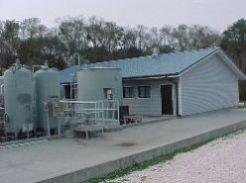Superfund: Post Construction Completion
Post construction completion (PCC) activities make sure Superfund response actions provide for the long-term protection of human health and the environment. PCC is the term used for several activities generally undertaken at sites following the construction of response actions. These activities include operation and maintenance (O&M) and long-term response actions (LTRAs), institutional controls, five-year reviews, and site deletion from the National Priorities List (NPL). Construction completions and remedial action project completions are also covered below as related sub-topics.
 Bayou Bonfouca Superfund site ground water pump and treatment station where construction has been completed.On this page:
Bayou Bonfouca Superfund site ground water pump and treatment station where construction has been completed.On this page:
- LTRA and O&M
- Remedial Action Project Completions and Construction Completions
- Institutional Controls
- Five Year Reviews
- NPL Deletion
Long-Term Response Action and Operation & Maintenance
You will need Adobe Reader to view some of the files on this page. See EPA’s About PDF page to learn more.
Included here is information and guidance on PCC topics including LTRA and O&M. For information and guidance on PCC topics such as CCs, RAPCs, FYRs, ICs and NPL Deletion go to Other PCC Topics.
Guidance and Informational Documents
These documents include guidance and policy documents as well as general fact sheets and information related to general PCC, O&M and LTRA.
| Title | Topic |
|---|---|
| Title | Topic |
Long-Term Response Action
The National Contingency Plan (NCP), 40 CFR 300.435(f)(3), states: "For fund-financed remedial actions involving treatment or other measures to restore ground- or surface-water quality to a level that assures protection of human health and the environment, the operation of such treatment or other measures for a period of up to ten years after the remedy becomes operational and functional will be considered part of the remedial action." The 10-year period between the “operational and functional” determination and the start of O&M is defined as an LTRA. “Operational and functional” is described in the NCP, 40 CFR 300.435(f)(2): "A remedy becomes 'operational and functional' either one year after construction is complete, or when the remedy is determined concurrently by EPA and the state to be functioning properly and is performing as designed, whichever is earlier. EPA may grant extensions to the one-year period, as appropriate." Ground water pumping and treatment and monitored natural attenuation remedies with objectives of aquifer restoration are the most common LTRA remedies.
Operation and Maintenance
O&M is an important component of a Superfund response, ensuring that the remedy performs as intended. Actions range from maintaining engineering containment structures (e.g., landfill covers) to operating ground water remediation systems. Generally, O&M is the responsibility of potentially responsible parties (PRPs), states or other federal agencies. EPA is responsible for ensuring that the work is performed adequately. EPA also retains funding and operating responsibility for Fund-financed ground water restoration systems for up to 10 years prior to transferring these systems to the states for O&M.
Post Construction Completion Topics
PCC activities include O&M and LTRAs (covered above), as well as institutional controls, five-year reviews and site deletion from the NPL. Construction completions and remedial action project completions are also covered below.
